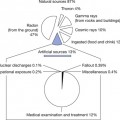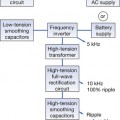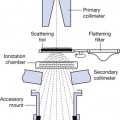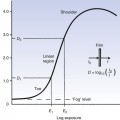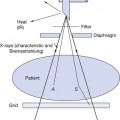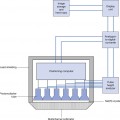Chapter 44 Practical radiation protection
Chapter contents
44.1 Aim
The aim of this chapter is to introduce the reader to the basic legal requirements for the safe use of ionizing radiation. This will cover the main documents involved in the UK and the basic organization of radiation safety in a hospital trust, and will then examine the practical ways in which these are implemented in radiology or radiotherapy departments.
44.2 Purpose and scope of radiation protection
Once the levels of risk from such radiation have been determined, appropriate dose-equivalent limits (see Sect. 44.6) may be set so that the risk associated with such radiations is no greater (and frequently is much less) than other aspects of life, e.g. the risk of injury as a result of a traffic accident. Establishing such dose-equivalent limits, and ensuring that staff work within these limits, helps to prevent suffering.
A full study of radiation protection would need to cover:
• statistical analysis of risk
• the fate and decay patterns of radioactivity released into the environment
• the absorbing power of different materials to different radiations.
Such a vast scope of study cannot be covered in a single chapter, or even in one book. Only a simplified review of practical methods of reducing radiation doses to radiation workers and their patients from the medical use of ionizing radiation will be considered here. These points are covered in the core of knowledge which all radiographic staff are expected to learn as part of their education. This consists of 11 key items as summarized in Table 44.1. Items 1–9 are of particular importance to the operator, while items 10 and 11 have particular reference to the role of the practitioner.
| 1 | Nature of ionizing radiation and its interaction with tissue |
| 2 | Genetic and somatic effects of ionizing radiation and how to assess these risks |
| 3 | The ranges of radiation dose given to a patient during the course of a particular procedure, the main factors affecting dose and methods of measuring dose |
| 4 | Principles of dose limitation and optimization |
| 5 | Principles of quality assurance applied to equipment and techniques |
| 6 | Specific requirements of children and of women who are or may be pregnant |
| 7 | Precautions necessary when handling sealed and unsealed radioactive sources |
| 8 | Organizational aspects of radiation protection and the procedure for suspected overexposure |
| 9 | Statutory responsibilities |
| 10 | Knowledge of the clinical value of the procedure requested, in relation to other available techniques |
| 11 | Importance of using radiological information, e.g. reports and images from a previous investigation |
44.3 Legal aspects
• Health and Safety at Work Act [HSW 1974].
• Ionizing Radiation Regulations [IRR 1999] Statuary Instrument 1999/3232.
• Radioactive Substances Act 1993 [RSA 1993].
• Ionizing Radiation (Medical Exposure) Regulations 2000 [IR (ME) R 2000] Statuary Instrument 2000/1059.
• Radioactive Substances (Hospitals) Exemption (Amendment) Order [RS (H) EO 1995].
• Ionizing Radiation (Medical Exposure) Regulations 2006 [IR (ME) R 2006] Statuary Instrument 2006/2523.
44.3.1 Organization of radiation safety
The employer (e.g. the hospital trust) is ultimately responsible for maintaining radiation safety for staff, patients and others who may be affected by their work active activities. They have specific obligations under the regulations and meet these through a number of radiation safety experts:
• The Radiation Protection Adviser (RPA): an accredited, medically qualified physicist who is appointed by the employer to advise the employer on radiation safety and compliance with the regulations. This includes the production of local rules and written systems of work, the designation of work areas, the supervision of quality assurance programmes and acceptance testing of new equipment.
• The Radiation Protection Supervisor (RPS): every area of the trust in which ionizing radiation is used must have an RPS appointed by the employer. Each RPS must understand the specific requirements of radiation safety as applied to their area of work. Since the RPS is responsible to the employer for ensuring the safety measures are implemented and maintained, such individuals are usually departmental superintendants as they have the authority necessary to do this.
• The Radiation Safety Committee (RSC): this committee oversees all radiation safety issues, including research, and ensures that the reports of the RPA are implemented and radiation safety standards are maintained.
44.4 Dose-equivalent limits
Table 44.2 summarizes the dose-equivalent limits specified by the Ionizing Radiation Regulations 1999.
Table 44.2 Dose-equivalent limits (in mSv) per calendar year specified by Ionizing Radiation Regulations 1999
| CATEGORY OF PERSON | DOSE TO WHOLE BODY | DOSE TO LENS OF THE EYE | DOSE TO SKIN AVERAGED OVER AN AREA OF 1 CM2 | DOSE TO HANDS, FOREARMS, FEET AND ANKLES |
|---|---|---|---|---|
| Employee aged 18 or over | 20 | 50 | 500 | 500 |
| Trainees aged under 18 | 6 | 50 | 150 | 150 |
| General public | 1 | 15 | 50 | 50 |
| Comforter or carer: no dose limit, however the Health Protection Agency (HPA) (formerly the National Radiological Protection Board) recommends the dose should not exceed 25 mSv over a 5-year period or 5 mSv in a single exposure. | ||||
